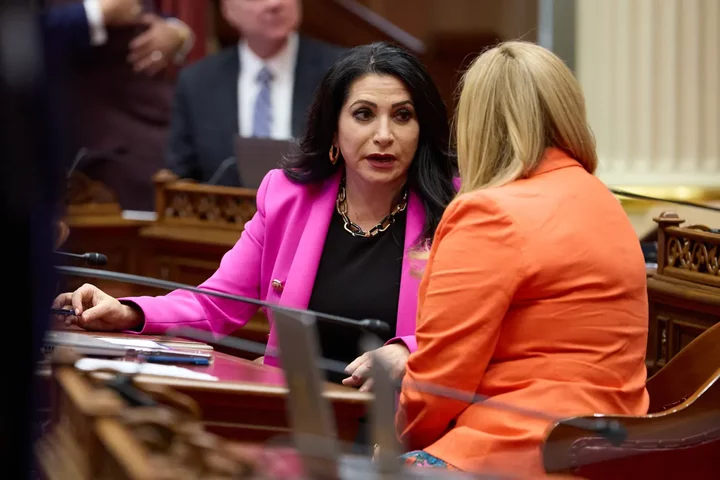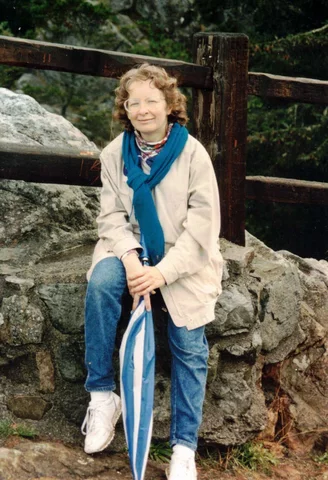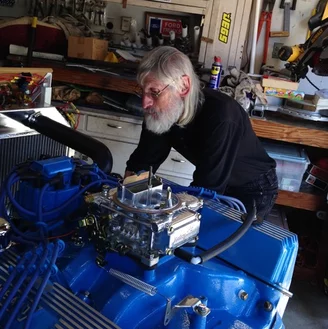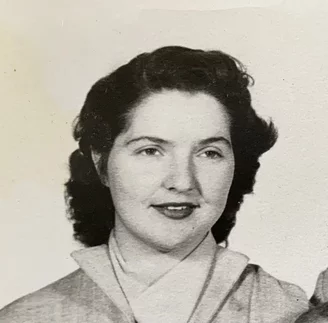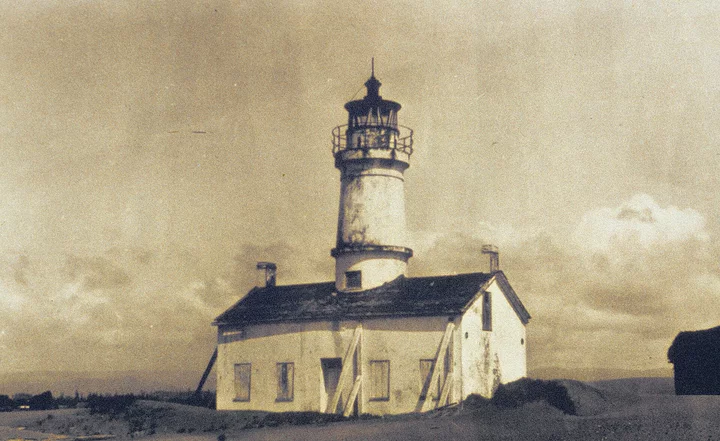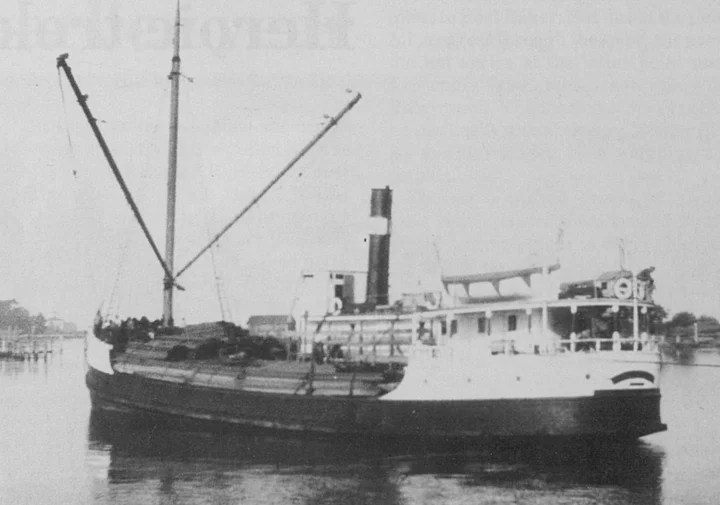As Wildfires Burn, a Corruption Probe Left the Senate’s Insurance Committee Chair Vacant
Ryan Sabalow / Monday, Jan. 13, 2025 @ 7:38 a.m. / Sacramento
State Senators Susan Rubio, left, and Angelique Ashby, right, talk during the first Senate floor session of the year this week. Rubio is thought to be linked to a sprawling corruption probe from her time as a Baldwin Park City Council member. Photo by Fred Greaves for CalMatters.
###
As fires rage through Southern California and exacerbate the state’s insurance crisis, the California Senate has no one in charge of its Insurance Committee due to questions surrounding a federal corruption investigation.Senate President Pro Tem Mike McGuire said he is waiting to hear from federal prosecutors about Sen. Susan Rubio, who’s been questioned in a federal corruption probe, before making a decision about reappointing her to her previous position as chair of the Senate Insurance Committee.
“We have requested and are awaiting additional information from the U.S. Attorney’s Office before finalizing any decisions,” McGuire’s office told CalMatters in an email.
Rubio, a Democrat from Baldwin Park, said she’s “currently not involved” in the federal corruption investigation that has already ensnared a handful of other officials in San Bernardino County, Compton, Commerce and Baldwin Park.
Federal officials have not identified Rubio by name in the case. However, there is nobody else matching the description of “Person 20,” who is accused in recently released federal court documents of asking for $240,000 in bribes from a cannabis company and accepting $30,000 in illegal campaign contributions. The allegations stem from when Rubio was a member of the Baldwin Park City Council.
The U.S. Attorney’s Office in Los Angeles is overseeing the case. A spokesperson declined to comment about who Person 20 is or say when – or if – charges would be filed against them.
Experts in federal corruption cases suggest that McGuire is right to be concerned.
At CalMatters’ request, three former federal prosecutors reviewed the court documents.
The prosecutors – one of them a former U.S. Attorney – said there’s no way the U.S. Department of Justice would make public that much identifying information about a suspect in a corruption investigation if they didn’t think they could convince a jury of his or her guilt.
“If federal prosecutors are putting that level of detail — especially in a public corruption matter — into a public-facing document, they are fairly confident that information is 120% correct,” said Carrie H. Cohen, a former assistant U.S. Attorney in New York and former chief of the public integrity bureau at the New York State Attorney General’s Office.
Mark D. Chutkow, the former chief of the U.S. Attorney’s public corruption unit and criminal division in Detroit, said “it would appear that there is more due to drop in this case.”
Chutkow said when it comes to public corruption cases, federal prosecutors typically have their sights on the “highest-ranking public officials and not necessarily on … middle persons and the bribers themselves.”
“This Person No. 20 would be a higher-ranking (official) and the more important target of the federal investigation,” he said. “So one would think that they would want to finish the job.”
Last week, Rubio declined to be interviewed by a CalMatters reporter as she departed the Senate after the first floor session of the new year. Instead, her office responded with an emailed statement.
“It’s unfortunate that Senator Rubio continues to receive questions based on a case that she is currently not involved with,” her spokesperson, Matthew Z’berg, said in an email. “Senator Rubio’s focus is on serving the constituents of the 22nd Senate District and addressing important issues affecting California families.”
Spokesperson says Rubio didn’t want insurance chair
Rubio did respond to Senate Pro Tem McGuire’s decision not to give her a committee leadership post when he recently announced his assignments for the two-year session that kicked off last Monday.
Last session, Rubio chaired the Senate Insurance Committee. The post was listed as a “vacancy” on McGuire’s list.
Z’berg said that Rubio told McGuire she wasn’t interested in being the insurance committee chair any more. She “encouraged (McGuire) to appoint a new chair to be announced with all other assignments.“She also conveyed to him that by leaving the position open, he would be feeding into false narratives and speculation,” Z’berg said.
Rubio also took a thinly-veiled shot at McGuire, suggesting that he’s playing politics by leaving the seat vacant due to speculation McGuire is eying a run for California Insurance Commissioner when he terms out in 2026.“Insurance issues affecting consumers across the state are of particular interest to him,” the statement read. “It is a critical issue that he has been very vocal about in the past, and will likely continue to do so.”In a statement emailed Friday, McGuire said “we’ve been leading on consumer-focused insurance reform for years — it’s personal for me because of the wildfires that have devastated the communities I represent. And this year will be no different.“The Southern California fires make it all the more clear how critical this issue is. Any premise that any legislation would be delayed is unequivocally BS,” he said. “A committee has been formed and we will name an insurance chair in the very near future.”The Insurance Committee is not scheduled to meet until March. Bills need to be in print for at least 30 days before legislators can act on them, so any new insurance-related legislation introduced this week wouldn’t be heard until at least February.
Is Sen. Rubio “Person 20”?
The recently released federal documents are a plea agreement signed by former Baldwin Park City Attorney Robert Tafoya. Federal officials released the agreement late last year. In the agreement, Tafoya says he helped facilitate bribes to local officials from companies seeking marijuana permits.
The Los Angeles Times was the first news outlet to report that Rubio matched the description of “Person 20.” The plea agreement describes Person 20 as a public official, in a position to be able to fire the city attorney, who won a primary for state office in 2018. No other local officials match the description.
The plea agreement says Person 20 sought $240,000 from a marijuana company seeking a city permit, but the company refused to pay that much so the deal fell through. Person 20 also sought and received $30,000 from Tafoya in a scheme to drum up support for Person 20’s 2018 state campaign, the documents say. Tafoya said he agreed to pay Person 20, in exchange for assurance he’d keep his city job and get state work from Person 20 after the election, according to his plea agreement.
Tafoya admitted to federal tax evasion and bribery charges in 2023, but prosecutors kept the plea agreement secret until last month since Tafoya had agreed to participate in the ongoing investigation.
“I have no idea who Person 20 is, but I am completely confident that the U.S. Attorney’s Office would not include these declaratory statements about Person 20’s actions unless they were very confident they could prove the truth of those statements in a court of law,” said McGregor Scott, a twice-appointed former U.S. Attorney based in Sacramento.Rubio has not directly answered whether she’s “Person 20.” She told the LA Times in a statement that she “volunteered hours of her time” aiding the authorities in their investigation and that she “has no reason to believe that she would be included in any criminal allegations.”

State Sen. Susan Rubio speaks during a session at the state Capitol in Sacramento on Feb. 20, 2024. Photo by Fred Greaves for CalMatters
Senate reviewing ethics complaint
Bill Essayli, a Republican Assembly member from Corona, requested the Assembly and Senate ethics committees to take up investigations after the LA Times report last month. Essayli spent about four years as a federal prosecutor in the U.S. Attorney’s Office that unsealed Tafoya’s plea agreement.
Essayli said he has no first-hand knowledge about this case since he left that job in 2018, but he said the allegations outlined in the plea agreement are troubling enough for the Legislature to act on its own without waiting for prosecutors. His ethics complaint also doesn’t identify Rubio by name.“When the Biden DOJ actually makes specific allegations like that against a sitting legislator, I don’t think we can wait as a public body for that investigation to play out – criminal investigations can take years to develop,” Essayli told CalMatters. “Meanwhile, this individual is still sitting in office. They still wield power in the name of the public, and they could be engaged in the same activity.”
Erin V. Peth, the chief counsel for the Senate Ethics Committee, told CalMatters Essayli’s complaint is under review, but provided no other details.
No woman California legislator has ever been indicted on public corruption charges while in office. Several male Assemblymembers and senators have been charged with such crimes over the years.
In 2010, state charges were filed against Los Angeles County Democratic Sen. Roderick Wright for voter fraud, perjury and other crimes stemming from him lying about actually living in his district. Then-Gov. Jerry Brown later pardoned Wright.
In 2016, a federal judge sentenced San Francisco’s Democratic Sen. Leland Yee to five years in prison for doing political favors in exchange for campaign cash.
Also in 2016, a federal judge sentenced Sen. Ron Calderon of Montebello to 42 months in federal prison for receiving over $150,000 in bribes. His brother, Assemblymember Tom Calderon, was sentenced to a year in prison for laundering his brother’s bribe money.
Following the Yee and Calderon indictments, voters in 2016 approved Proposition 50, which gives legislators the authority to suspend a disgraced colleague without pay. Doing so requires a two-thirds vote of the lawmaker’s chamber.
###
CalMatters.org is a nonprofit, nonpartisan media venture explaining California policies and politics.
BOOKED
Yesterday: 9 felonies, 10 misdemeanors, 0 infractions
JUDGED
Humboldt County Superior Court Calendar: Today
CHP REPORTS
Us101 N / Westhaven Dr Ofr (HM office): Trfc Collision-1141 Enrt
ELSEWHERE
Mad River Union: One year until Humboldt’s budget ‘up a creek’
Mad River Union: Arcata Fire’s popular services exceed its available resources
Mad River Union: Blue Lake hires Jennie Short as city manager
Mad River Union: ‘Random dude’ with knife attempts McK robbery
A Week From Hell: See How LA Fires Destroyed Neighborhoods From Coast to Foothills
CalMatters Visuals Team / Monday, Jan. 13, 2025 @ 7:32 a.m. / Sacramento
A person is surrounded by wildfire smoke on Pacific Coast Highway during the Palisades Fire, on Jan. 7, 2025. The fire devastated the coastal communities of Pacific Palisades and Malibu. Photo by Ted Soqui for CalMatters
Charred skeletons of beloved homes. Desperate homeowners endangering their lives as they hose down their burning roofs. Emergency workers carefully carrying a body bag out of the rubble. An American flag in blackened tatters.
The images arriving in the wake of the wind-driven wildfires in Los Angeles County are haunting, giving all of us a window into the pain, grief and devastation facing hundreds of thousands of people.
CalMatters contributing photographers Ted Soqui and Jules Hotz were dispatched to Pacific Palisades and Malibu, along the Los Angeles coast, and Altadena, in the foothills of the San Gabriel Mountains, to chronicle the impact of one of the worst disasters in California history.
As of Sunday, an estimated 12,000 houses, businesses, schools and other structures have been damaged or destroyed, at least 24 people have died and about 150,000 people were ordered or warned to evacuate.


The Eaton Fire burns in the community of Altadena. Because of overwhelming demand, firefighters were unable to get water from hydrants that ran dry, as homes and businesses burned, on Jan. 8, 2025. Photos by Ted Soqui for CalMatters

People fleeing the fire carry their belongings as they evacuate their homes during the Palisades Fire, near Sunset Boulevard and the Pacific Coast Highway, on Jan. 7, 2025. Photo by Ted Soqui for CalMatters


First: Super Scooper firefighting aircraft load up with water off the coast of Los Angeles on Jan. 7, 2025. Last: Firefighters attempt to put out a fire at a home in Altadena, on Jan. 8, 2025. The community was devastated by the Eaton Fire. Photos by Ted Soqui for CalMatters

A person uses a hose to spray water on the flames of a house to prevent the Eaton Fire from spreading to more homes in Pasadena on Jan. 8, 2025. Photo by Jules Hotz for CalMatters

Burned homes smolder in the aftermath of the Palisades Fire on Pacific Coast Highway near Malibu, on Jan. 9, 2025. Photo by Ted Soqui for CalMatters


First: A burned and tattered American flag waves on a flagpole after the Palisades Fire on Jan. 9, 2025. Photo by Ted Soqui for CalMatters Last: A fireplace remains standing after a home was burned down by the Eaton Fire in Altadena on Jan. 8, 2025. Photo by Jules Hotz for CalMatters

Firefighters work to put out a fire in the rubble of a home that burned on Pacific Coast Highway near Malibu, as a result of the Palisades Fire. Jan. 9, 2025. Photo by Ted Soqui for CalMatters


First: Smoke from the Eaton Fire and surrounding wildfires fills the air around downtown Los Angeles. Last: A vivid sunset as smoke from the Palisades Fire fills the sky in Santa Monica. Jan. 9, 2025. Photos by Jules Hotz for CalMatters

Emergency crews remove a body from a burned home off Pacific Coast Highway, near Pacific Palisades, on Jan. 9, 2025. Photo by Ted Soqui for CalMatters

Two people survey the damage of their home that was burned to the ground in an Altadena neighborhood during the Eaton Fire on Jan. 8, 2025. Photo by Jules Hotz for CalMatters
###
CalMatters.org is a nonprofit, nonpartisan media venture explaining California policies and politics.
OBITUARY: Regina Anglin (Wood), 1950-2024
LoCO Staff / Monday, Jan. 13, 2025 @ 7:19 a.m. / Obits
Regina
Anglin (Wood) left this world peacefully, at the age of 74 on
November 25, 2024 surrounded by family at her bedside after a brief
illness.
Born Regina Louise Wood on March 1, 1950 to Bernard and Margaret Wood in Omaha, Nebraska, Gina (as she was known) was the fourth of what would become 12 Wood children.
Gina was preceded in death by her loving husband, Steven Harvey Anglin; her grandchildren, David Woodruff, Marriah Woodruff and Christopher McClaren; her siblings, Thomas, Barbara and Joseph Wood; and her parents, Bernard and Margaret Wood. She is survived by her siblings, Christine Burton, Catherine Phipps, Margie Wood (Virginia), Michael Wood (Katie), Bernie Wood (Lidia), Lori Wood, Angela Papstein and Charles Wood (Mundz); her stepdaughter, Annette McClaren; her stepson, Will Woodruff (Dawn); and numerous grandchildren, nieces and nephews.
She attended St. Bernard’s High School in Eureka and worked for 45 years as a pharmacy technician at St. Joseph Hospital until her retirement. Gina had a deep faith in God and was an active member of the Seventh Day Adventist Church, where she fostered many friendships.
To those who had the privilege to know her she was the most kind, gentle and sweetest person in the world. She had a love of gardening and the outdoors, sewing, quilting, soap making and camping, throughout her life she shared these passions freely with friends and family.
A celebration of life for Gina will be held on Saturday February 15, 2025 at 2:30 p.m. at Seventh Day Adventist Church: 4251 F Street, Eureka.
###
The obituary above was submitted on behalf of Regina Anglin’s loved ones. The Lost Coast Outpost runs obituaries of Humboldt County residents at no charge. See guidelines here. Email news@lostcoastoutpost.com.
OBITUARY: Howard Quintin Baer, 1942-2024
LoCO Staff / Sunday, Jan. 12, 2025 @ 6:56 a.m. / Obits
Howard Quintin Baer, 82, of
Bayside, passed away peacefully on December 9, 2024, at Queen of the
Valley Hospital in Napa. Born on September 20, 1942, in Mt. Vernon
Ohio, Howard lived a life full of love, dedication and service to his
community.
Howard is survived by his beloved wife of 58 years, Kathy Baer; his daughter Cindy Matney; his son Greg Baer; his beloved granddaughters Jenae Hagler and Madeline Marie Baer; and his great-granddaughter Hayden Hagler. He was predeceased by his parents and siblings.
Howard was a devoted educator and school administrator who touched the lives of countless students and colleagues. He began his teaching career as an auto shop teacher and later became the principal of Arcata’s Pacific Coast High School, a position he held for many years. After moving from Ohio to Stockton when he was 18, he then moved to the Arcata area in 1963, where he earned both his bachelor’s and master’s degrees at Humboldt State University.
Outside of his professional life, Howard was known for his kindness, wisdom and unwavering commitment to his family. His hobbies revolved around working with his hands through woodworking, house projects and, most notably, car projects. His most beloved car was his 1978 Ford Fairmont station wagon, affectionately known as “the wagoon,” which had a very strong 2.3L engine as evidenced while climbing the hills of Highway 299. He also owned and tinkered with other classic cars such as a Model A, Rambler station wagon, Ford Thunderbird, Mercury Park Lane convertible and his son’s 1967 Mustang.
Howard was a long-time member and officer of the Humboldt Model A Club. He held the position of vice-president for many years and planned all the meal gatherings and car cruises with meticulous work, determining restaurant venues, keeping a card file, and arranging lodging for some of the most memorable trips including Fort Bragg, Gold Beach and the Rouge River. Even after he took ill, Howard continued to phone members about monthly arrangements. His home and garage (shop) hosted club picnics and some of the Christmas gatherings and many “tool talks,” where he was always generous with his car advice.
Howard was also known for his dry sense of humor, often bringing laughter to those around him. He had a unique way of answering many questions with the ending caveat, “unless it rains…”
Summers were spent with his family at Trinity Lake, where Howard taught both of his children to water ski, creating cherished family memories that will last a lifetime.
Howard’s legacy of dedication, love and service will be remembered by all who had the privilege of knowing him.
Howard’s memory will live on in the hearts of his family, friends, former students and all those he inspired and mentored throughout his life. He will be deeply missed.
###
The obituary above was submitted on behalf of Howard Baer’s loved ones. The Lost Coast Outpost runs obituaries of Humboldt County residents at no charge. See guidelines here. Email news@lostcoastoutpost.com.
OBITUARY: Grace Louise Baker Cates, 1933-2024
LoCO Staff / Sunday, Jan. 12, 2025 @ 6:56 a.m. / Obits
Grace Louise Baker Cates passed away peacefully November 23, 2024 at
the Ida Emmerson Hospice House in Eureka at the age of 91. She was
born August 27, 1933 in Broken Bow, Oklahoma to Aubrey and Alda
Baker, the 6th of 7 children. She had successfully conquered lymphoma
several times, undergoing treatment without much complaint. She had
decided if it returned she would not seek any type of intervention
and those wishes were fulfilled by the compassionate discharge
planning staff at Providence St. Joseph Hospital and Hospice of
Humboldt.
Grace often talked about her time as a child growing up in Oklahoma and some of the mischief she and her siblings got into. Once she told a story of she and her brothers being outside in a field by a wood pile. Her brothers asked her to hold an object (maybe a piece of wood?) over her head while they tried to shoot it. She didn’t mention what their weapon was, hopefully not a BB gun! Grace also reminisced about her mother baking fresh bread and biscuits. She said she could still remember how wonderful they smelled right out of the oven! She recalled going to church as a young girl and even though she hadn’t attended church for many years her faith was so important to her.
The Baker family moved west to southern California in the 1940 and after several moves to other places finally settled in Humboldt County. Grace began her education in Oklahoma and eventually graduated from Arcata High School in 1951.
Grace married Robert “Bob” Cates on May 25, 1953. They welcomed four children in the next several years, Sharon Louise, Brenda Sue, Robert Dale and Richard Lee. During the early years of their marriage they lived in Arcata, Willow Creek and finally settled in Eureka where they raised their family. Grace and Bob were married for nearly 37 years when he passed away on April 8, 1990.
Grace had several jobs throughout her life, the first as a young waitress at the Samoa Cookhouse. She was also a telephone operator in Arcata in the 1950s. She said she worried that she wouldn’t make the correct connection and also said that some people on the other end of the line could not always understand her quiet voice. it flustered her until she realized she couldn’t understand a lot of them either!
Bob owned and operated the Texaco station across from Chin’s on Broadway and then later on the corner of 4th and R streets in the mid 1970’s. Grace would show up every night just before closing time to get the readings off the gas pumps. She was almost always accompanied by her children, most of them appearing so shy they could barely speak. She probably told them to be on their best behavior, especially if anyone other than their father was there. Grace was later the bookkeeper for Finnegan and Nason Auto Supply in Henderson Center for many years until her retirement.
Family meant everything to Grace! She was a dedicated and loving daughter, sister, wife, mother, grandmother and great-grandmother and definitely a bit of a worrier when it came to the well-being of all those she cared about. She lost her father at an early age and lovingly cared for her mother until her death. She always, always thought of others before herself. She loved preparing Sunday dinners that she graciously shared with anyone who showed up. There was always plenty of delicious food, especially her fresh, homemade buns. She also enjoyed playing Skip-Bo and Aggravation with her mother and her sister Nell. It seems like the table was always set up for some sort of competitive game. Her children remember Sunday drives when they were young that often included a picnic lunch. Some of Grace’s favorite foods were good peanut brittle, Winco strawberry ice cream (yes, it absolutely had to be Winco brand for Grace!), lots of bananas but not too ripe, chocolate and Chinese food.
In later years, especially when Grace was no longer driving, she passed her time with daily phone calls and sometimes visit from family and friends, watching TV (she didn’t miss an episode of Days of Our Lives, she even learned how to stream it!) and tackling many, many word search books. She said she didn’t really like to read books much but thoroughly enjoyed her magazine subscription to Good Old Days. Lately though, she thought the stories in the magazine were too recent; not from the good old days she remembered. She also found some articles that caught her interest in the Humboldt Historian and really looked forward to the Thursday edition of the Times Standard that included the TV guide for the upcoming week.
As Grace’s health and ability to navigate on her own declined her family encouraged her to get an alert bracelet so she could easily contact someone if she fell, etc. Being a bit stubborn she would not even consider it. Much to the amazement of the firemen who came to help her up on more than one occasion, Grace had learned to talk to “Alexa”. Her newfound friend Alexa was able to do the work of the alert bracelet and was someone to talk to besides! She did not want anyone to fuss over her but was so happy when then did anyway. “Oh Hon, you didn’t have to do that!” was a familiar phrase from Grace.
Grace definitely had an opinion on most everything but didn’t always verbalize it. She was so very sweet and kind. She hardly, if ever, spoke harshly about anyone. The only person she had a hard time tolerating will be inaugurated as our president on January 20th for the second time. That would have been a depressing day for Grace and we are grateful God’s plan was that she didn’t have to be here to witness it. Grace, you can truly rest in peace now.
The last 10 days of Grace’s life were spent in the hospital and eventually the Hospice House. She was so very grateful to be surrounded by family and close friends and was most happy that her son Dale was able to be with her during that entire time. She was ready for her journey here to be over and to be reunited with all those who had gone before her.
Grace was predeceased by her parents, her husband Bob, her siblings, Aud, Nell, Elsie, Virginia, Alvin and Doris, her daughter Brenda, her son Rick and numerous nieces and nephews. She is survived by her daughter Sharon Rogers (Larry), son Robert Dale Cates, grandchildren, Jennifer, Phoebe, Adam, Matthew, Lori and Tyler as well as several great-grandchildren and many nieces and nephews.
There will be no formal service for Grace. Please remember her by thinking of someone you know who lives alone. Make the time to call them and more importantly, if possible, take the time to visit them. Ask questions about their life and what matters. Or sit in silence together. Watch daytime TV together. Share laughter, some cookies and a smile. Make the time spent together meaningful to you both and know that your presence was priceless.
If you wish, kindly make a donation in Grace’s name to Hospice of Humboldt, 3327 Timber Fall Ct., Eureka, CA 95503.
###
The obituary above was submitted on behalf of Grace Cates’ loved ones. The Lost Coast Outpost runs obituaries of Humboldt County residents at no charge. See guidelines here. Email news@lostcoastoutpost.com.
THE ECONEWS REPORT: Green Burial — Thinking Outside the Coffin
The EcoNews Report / Saturday, Jan. 11, 2025 @ 10 a.m. / Environment
Image: Stable Diffusion.
“All go to one place; all are of the dust, and to dust all return.”
— Ecclesiastes 3:20.
That was true, at least until the Civil War era. Then a desire to preserve bodies led to a new way of dealing with the dead: toxic embalming, water-tight coffins and concrete vaults. For many of us who try to live simple, low-impact lives, our deaths present a dilemma. We can’t go simply or sustainably into whatever comes next.
But there is another way. Imagine breaking down quickly, wrapped only in a shroud or in a biodegradable casket, eighteen inches under the soil, your nutrients being taken up by a tree. Michael Furniss, soil scientist and green burial enthusiast, is working to make that a reality in Humboldt. Michael joins the show to discuss the green burial movement, the science behind natural burial, and efforts to create a conservation burial ground in Humboldt.
For more, check out Sacred Family Groves.
HUMBOLDT HISTORY: The Treacherous Entrance to Humboldt Bay Harbor Wrecked Ships Left and Right. Was There Any Possible Solution?
Susan Pritchard / Saturday, Jan. 11, 2025 @ 7:30 a.m. / History
The original Humboldt Bay lighthouse on the North spit in 1920, long after it had been deactivated. Author: Unknown. Public domain.Via Wikimedia.
Humboldt Bay is a natural land-locked bay about 100 miles south of the Oregon state boundary. It lies in an indentation, or bight, in the coastline and is one of the few natural bays on the Pacific Northwest coast. It is approximately fourteen miles long and varies in width from three and a half miles to a half mile, with an average width of three quarters of a mile. Several small creeks empty into the bay, but no streams of consequence are tributary to this waterway.
The bay is separated from the ocean by two narrow sandy spits, whose ends form the entrance. A mile seaward of the spit heads lies a sand bar, a typical formation on the Pacific Coast.
Major William W. Harts, of the U.S. Army Corps of Engineers, described the sand bars found at all of the harbors along the coast. The harbor entrance is “obstructed by a crescent-shaped encircling bar. …The distance and the depth of water overlying the bars are largely dependent upon the area of the tidal prism within the bays and the exposure to storm action.” Through the bar, and the entrance, are channels carved in the sand by the tidal action. At Humboldt Bay “the channel through…[the] entrance, in its natural state, was shifting and dangerous, being uncertain as to position, width and depth, and averaging a mile in length.”
Complicating the uncertainty of the channel is the stormy conditions that are prevalent on the coast. It has been maintained by ship masters “that nowhere else have they encountered such waves as off Humboldt.” The entire crescent of the bar in its unimproved state was frequently a field of breakers. The dangers and hazards of the entrance to Humboldt Bay stem from the combined conditions of the bar, the violent and unpredictable waves, and the shifting and often shallow nature of the channel.
As early as 1850, when Hans H. Buhne first piloted the schooner Laura Virginia into Humboldt Bay, the dangers of the bay’s entrance were recognized. The passengers and crew of the Laura Virginia formed an association that was searching for the bay whose discovery by the Josiah Gregg party had been reported in San Francisco.
After seeing a smooth stretch of water that was presumed to be the bay, Buhne, the second officer, was sent to take soundings and see if it was possible to guide the Laura Virginia into the bay. After having crossed the bar in a small boat that was swamped twice before reaching land, Buhne returned and guided two more of the Laura Virginia boats into the bay. The passengers in one of these boats became so apprehensive that they almost refused to cross the bar after seeing the “terrific breakers… [that] mark…[the] line where the waves of the ocean meet the ebb tide.” The entrance to the bay itself was almost obscured by those breakers.
Despite the hazards encountered by Buhne and the Laura Virginia Association, the full extent of this navigation barrier to trade and development was not immediately recognized. The early settlers did not have many exports, and the shipping was limited. For example, during the first half of 1852, only six vessels from the Humboldt region arrived in San Francisco. The rise and development of the lumber industry rapidly changed the numbers of ships upon the bay. Only a year later 143 ships made the trip to San Francisco from Eureka with large loads of lumber. The full threat of the bay entrance to shipping became obvious by the late 1850s. By 1855, even with a tug in operation to guide schooners in and out of the bay, twelve ships had been wrecked trying to navigate the entrance. The alternate to risking a crossing when the entrance was rough was to remain “bar-bound” for days, unable to cross the bar because of the high waves.
During the stormy winter months ships were often kept in the harbor for weeks, unable to leave with their valuable cargoes of redwood lumber. Other ships found it necessary to leave the bay only partially loaded so that they could make it across the bar with its shallow channels.
The maps of the United States Coast and Geodetic Survey were an attempt to help mariners enter the harbor. The earliest map done by the Survey in 1851 gives the following advice on how to enter and find the bay. The sailing directions began with a description of the bay:
This harbor may be easily recognized by a remarkable red bluff facing the entrance with a perpendicular front to the sea of 96 feet, and by the headland known as Table Bluff, five miles to the southward. To enter the harbor, bring Howard’s House (a large four story white house), to bear by compass S.E. and well on width a point of trees on the highland two miles back. Run in on this range until across the bar, when the breakers on either side of the channel will be sufficient guide to the anchorage.
These directions were only satisfactory for a few years. The natural erosion of the heads of the spits by the waves greatly altered the entrance by 1858. The channel had also moved from a northwesterly position to an almost due west location. Recognizing the variableness of the channel, the coast survey maps, beginning in 1858, no longer gave sailing directions and the individuals crossing the bar were dependent upon the pilots for help.
An example of a typical crossing experience is described by some of the soldiers and their wives who came to establish Fort Humboldt in January of 1853. The notorious reputations of the entrance was known by all on board the steamer Goliah. When the Goliah reached the bay, the Captain, “Old Bully Wright,” found the bar too rough to attempt a crossing. It was necessary to wait until the following day when the conditions were more favorable for a crossing.
Wright refused to signal for a pilot, believing that he knew the entrance as well as anyone. The surgeon’s wife, Mrs. Underwood, was not as sure about their safety when she saw the “masts of several wrecked vessels that were evidence of the dangers of ‘crossing the bar’.” Lt. George Crook was also concerned about making the difficult passage. He commented in his autobiography that “we labored on the bar, the old ship nearly breaking in two. All on board experienced great relief when we were safely over.” Most who crossed the bar felt a similar relief in finding that they had survived the treacherous crossing. Not all were as lucky.
With the increase in shipping, stimulated by the rapid growth of the lumber industry and the development of agricultural pursuits, came an increase of tragedies involving the crossing of the bar. An example is a drowning accident that occurred in February 1870. The Humboldt Times reported that the Captain of the brig Crimea had been washed overboard. Captain Lassen was the sole owner of the brig, and was concerned with its safety while crossing the bar. The brig was towed out of the entrance and across the bar through the channel by one of the tugboats on the bay. Lassen was last seen “in the main rigging of his vessel, but no one saw him when he fell or was carried overboard by the sea, nor indeed, does it seem that he was missed until she had cast off from the tug.” It was the consensus of the crew that Captain Lassen had been washed overboard by one of the several heavy seas that had hit the Crimea while she was crossing the bar.
The dangers of the bay entrance were cited in the statistics of the United States Life-Saving Service whose annual reports “chronicle more terrible shipwrecks at Humboldt Bay than at the great port to the south (San Francisco).” Though the dangers of the bay entrance were recognized, little was done to lessen the hazard in the first forty years following the settlement of the Humboldt Bay region.
One of the most tragic bar wrecks, in terms of loss of life, was that of the lumber steamer Brooklyn, shown above, in its prime. The photo below shows all that remained after the vessel rolled over crossing the bar in high seas on Nov. 8, 1930. Of the crew, 19 men were lost and one survived. Photos via the Humboldt Historian.
The first step taken toward greater Humboldt Bar safety was the erection in 1856 of a lighthouse tower near the entrance, on the North peninsula, by the lighthouse service. The money for building the tower was first appropriated in 1851, but construction was delayed by inadequate funding, poor transportation, and problems with contractors. These problems, caused by lack of foresight, continued to plague all future improvements on Humboldt Bay in the nineteenth century. Even after the tower was completed, inadequate planning resulted in more construction. For example, when mariners complained that the original structure was too low, it was necessary to raise the tower several times. It was almost twenty years after the lighthouse was completed that a bell boat was added in 1872 to the entrance warning system to help warn ships during the dense fogs that plagued the coastline. In one year the keepers at the Humboldt lighthouse logged “over 1,100 hours of fog.” Due to the stormy weather the bell boat was short lived, and was replaced in 1874 with a steam whistle.
Despite the continual improvements to the lighthouse and its warning system, mariners were still dissatisfied with the performance of the lighthouse. In 1886, after a series of severe storms and unusually high tides had nearly destroyed the structure. Congress was petitioned for permission to move the lighthouse to the nearby large bluff four miles to the south of the bay entrance. Other reasons for removal of the lighthouse were the complaints of mariners and the opinion of the Lighthouse Board that the bay entrance was not the best location for the structure. It was the belief of the Lighthouse Board that the proximity to the Humboldt bar, with its constantly breaking waves, not only cut “the sound of the fog signal, but it also obscures the light when the weather is generally clear.” The Humboldt lighthouse closed on October 31, 1892, and the Table Bluff lighthouse began to warn of the dangers along the Humboldt coastline. The buildings of the old lighthouse would be used by the engineers of the Army Corps while they sought other, more concrete ways to improve the entrance to Humboldt Bay.
One of the first to call for more physical improvements was the editor, William Ayres, of the Democratic Standard. Ayres, beginning in 1877, began agitating in his editorials for “securing congressional assistance for the improvement of our harbor.” He was convinced that the natural potential of Humboldt Bay as a shipping harbor needed to be developed, and the only way to do that was by creating an entrance and harbor that allowed easy ingress and egress of ships of great draft.
Ayres was a man of vision. He saw Eureka and Humboldt Bay as becoming the commercial center of Northern California. He believed that with an expenditure as low as $300,000 the bay could be improved and that Eureka and Humboldt Bay could become “inevitably…the great initial shipping point for all foreign vessels engaged in the redwood lumber trade and for the great bulk of the shipping that is done from Humboldt County, particularly for all that portion any considerable distance inland.” With this object in mind, Ayres worked diligently for his cause during the seven years that he was editor of the Democratic Standard. It was largely due to his activities that the attention of Congress and the Army Corps of Engineers was drawn to the Northern California bay, and a series of attempts launched to improve the bay entrance.
Ayres’ first editorials met with little success. He was not dissuaded, and argued frequently and articulately about the benefits to be gained from improving the bay. It was Ayres’ belief that the harbor improvements would help not only Humboldt County, but also the surrounding counties of Del Norte, Siskiyou. Trinity and Shasta. He hoped that with the support of these counties it would be possible to get the attention of Congress and its support for the improvement of the bay.
Ayres’ estimate of $300,000 to improve the entrance was too great a sum for the recently formed County of Humboldt or City of Eureka to finance. It was also too great of a sum to be raised from the lumber barons who stood to profit most from the scheme. The industry was recovering from the severe national depression of the 1870s and was little inclined to fund a project of unknown results. Thus, it was necessary to turn to the federal government, who through the Corps of Engineers during the Nineteenth Century had become increasingly active in harbor and river improvements, in the interest of both national security and commerce.
It was the Corps whom Ayres wished to reach, as they had the knowledge, technical expertise and experience to improve the bay entrance.
It was Ayres’ belief that by increasing the depth of water across the bay by six feet a great surge in the amount of shipping would result. It was necessary for him to convince such doubters as Captain Hans H. Buhne, who had piloted the Laura Virginia, and, as late as 1881, still maintained that it was impossible to improve the treacherous entrance. In order to convince Buhne and others, Ayres turned to economic justifications for his plans.
In an article on April 27,1878, Ayres explained how the additional six feet of water over the bar would benefit the shippers on the bay by using a concrete example of the cost of shipping a million feet of lumber from Eureka to San Francisco. Under the conditions of the period, it was necessary to ship that amount of lumber in at least five different cargoes. The cost for shipping the million feet at the 1878 shipping and towing charges on the bay came to $5,750. According to Ayres, with an increased depth on the bar ships of greater draught could utilize the harbor and it would only be necessary for two cargoes to transport the million feet of lumber. Ayres then argued that lower rates could be charged for both the towing and shipping charges. Using the contemporary costs of towing and shipping, Ayres believed the increased depth of the bar would result in a savings of $45,000 for the individual shipper. These statistics would have been very impressive to the lumbermen in the area who were recovering from a devastating national depression.
Beyond the immediate savings to the lumber companies, Ayres was convinced that the improved entrance to Humboldt Bay could result in an increase in the amount of shipping. The lower charges would open up foreign markets to redwood lumber which had previously been closed because of high shipping costs. Ultimately, Ayres argued, the additional six feet of water over the bar would result in the immediate doubling of the “value of every foot of redwood timberland in our county or contiguous to it. Thinking minds who are interested in the growth and development of this section should consider this proposition well.”
###
Next: The rocky course toward bay improvements.
###
The story above is excerpted from the January-February 1989 issue of the Humboldt Historian, a journal of the Humboldt County Historical Society. It is reprinted here with permission. The Humboldt County Historical Society is a nonprofit organization devoted to archiving, preserving and sharing Humboldt County’s rich history. You can become a member and receive a year’s worth of new issues of The Humboldt Historian at this link.

